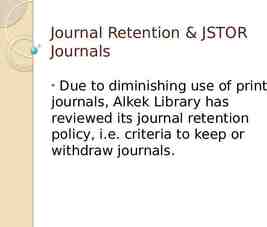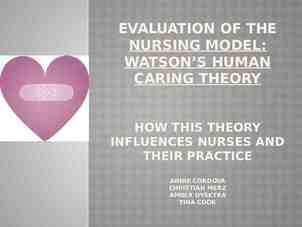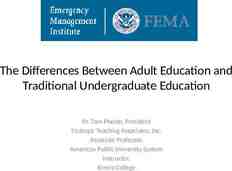Chapter Four: Implied Main Ideas Anything you read has two
8 Slides1.07 MB
Chapter Four: Implied Main Ideas Anything you read has two basic parts: a main idea and the supporting details that explain and develop that idea. The main idea is usually clearly stated in one sentence of a selection. However, the main idea is sometimes implied— only suggested by the supporting details and not clearly stated in one sentence. To figure out an implied main idea, you’ll need to look at the supporting details.
What is the implied main idea of the cartoon? Copyright 1997 by Randy Glasbergen. www.glasbergen.com
You can figure out the implied main idea by looking at the supporting details: 1. The man’s coworkers are complaining that he doesn’t leave coffee for anyone else. 2. He has such a caffeine high that he is flying! The clearly implied idea is that he is drinking too much coffee. HERMAN: Jim Unger/Dist. By Newspaper Enterprise Association. Inc.
Read the following paragraph and see if you can figure out its main idea. All people are concerned about a few great questions: the existence of God, the purpose of life, the existence of an afterlife, and morality. About the first, science has nothing to say: no test tube has either proved or disproved God’s existence. As to the purpose of life, although science can provide a definition of life and describe the characteristics of living organisms, it has nothing to say about ultimate purpose. Regarding an afterlife, science can offer no information, for it has no tests that it can use to detect a “hereafter.” As for the question of morality, science can demonstrate the consequences of behavior but not the moral superiority of one action compared with another. Science cannot even prove that loving your family and neighbor is superior to hurting and killing them. The above paragraph has no good “umbrella” statement that covers all the other sentences. To decide on the main idea, we must ask the same three questions we’ve already used to find main ideas: Who or what is this paragraph about? (The answer is the topic of the paragraph.) What is the main point the author is trying to make about that
All people are concerned about a few great questions: the existence of God, the purpose of life, the existence of an afterlife, and morality. About the first, science has nothing to say: no test tube has either proved or disproved God’s existence. As to the purpose of life, although science can provide a definition of life and describe the characteristics of living organisms, it has nothing to say about ultimate purpose. Regarding an afterlife, science can offer no information, for it has no tests that it can use to detect a “hereafter.” As for the question of morality, science can demonstrate the consequences of behavior but not the moral superiority of one action compared with another. Science cannot even prove that loving your family and neighbor is superior to hurting and killing them. Who or what is this paragraph about? In the paragraph, all the details are about science and great human concerns, so that must be the topic. What is the main point the author is trying to make about that topic? Science alone cannot tell us about the four main concerns that all people have. Does all or most of the material in the paragraph support this main idea? Yes. Every sentence is about the “great questions” people are concerned about and the lack of information science provides about them.
Check Your Understanding Read the following selection and try to answer the questions that follow. The original intention of a school worksheet was intelligent: to discover which students didn’t understand the reading lesson, so the teacher could work with them individually. Unfortunately, the teacher had to keep the rest of the class busy while doing that, so more worksheets were passed out. The assessment tool soon turned into a crowd control device. To make matters worse, the worksheets multiplied faster than the loaves and fishes, often reaching 1,000 per child per school year. But research shows no connection between the number of worksheets a student does and how good a reader the child eventually becomes. If you’re fed reading as six worksheets a day, 1,000 sheets a year, under the pronouncement, “Boys and girls, it’s time for reading,” by the time you reach fourth grade you think worksheets are 1. What and is the topic of the above 2. Which statement best expresses the unstated reading, you mistakenly think you hate reading. paragraph? main idea of the paragraph? A. School worksheets A. School worksheets may do more harm than B. Books good. B. Reading is one of the most difficult skills for C. Teaching tools teachers to teach and students to learn. D. Crowd control devices C. Over the years, school worksheets have served as both an assessment tool and a crowd control device. D. Teachers have a variety of teaching tools to choose from.
The topic, referred to in a number of sentences in the paragraph, is school worksheets. The implied main idea about worksheets is that they may do more harm than good. When you think you have figured out an implied main idea, test yourself by asking, “Does all or most of the material in the paragraph support this idea?” In the paragraph, the author describes how worksheets have multiplied out of control, have not proved to benefit students, and even make students hate reading. So the paragraph clearly supports the idea that worksheets do more harm than good.
Chapter Review In this chapter, you learned the following: At times authors imply, or suggest, a main idea without stating it clearly in one sentence. In such cases, you must figure out that main idea by considering the supporting details. To find implied central points in longer reading selections, you must again look closely at the supporting material. The next two chapters—Chapters 5 and 6—will explain common ways that authors organize their material.













